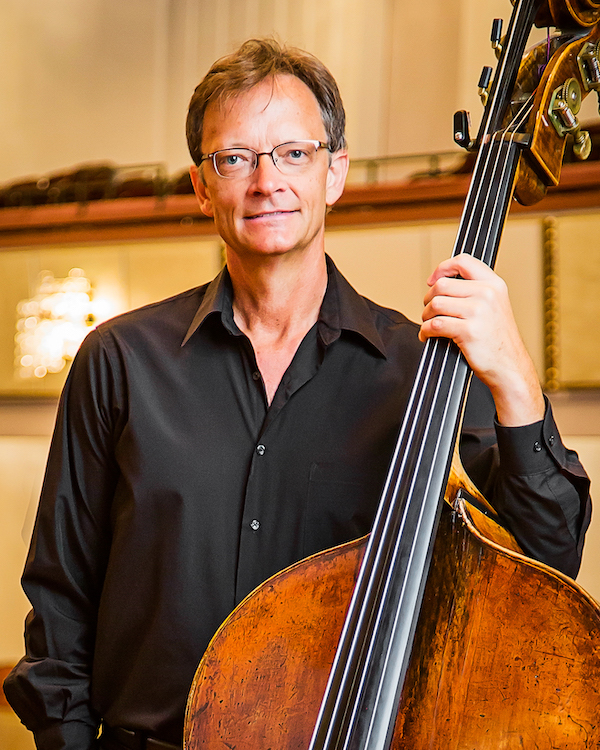NSO, Noseda play “Name That Tune” in quirky evening of composer surprises

NSO principal double-bass Robert Oppelt was among the soloists at the National Symphony Orchestra’s concert Thursday night. Photo; Scott Suchman
When the National Symphony Orchestra has to sell only 250 seats to fill the Kennedy Center Concert Hall, it opens up some possibilities.
On Thursday night, for the second of music director Gianandrea Noseda’s programs before a live audience since the start of the pandemic, that meant a “surprise” concert. No program was published before the concert or handed out, leaving listeners the chance to encounter the music without any preconceived notions.
Noseda clearly relished his role as puzzle-master, teasing the audience with hints about each of the six pieces before the NSO played them. He would then playfully field guesses from the crowd before revealing the composer’s name after each performance. The selections were generally off the beaten path, with only about half identifiable by critical ears. The experience was something like a musical trivia night, with an exceptionally charming Italian host.
(This review will avoid spoilers to preserve the experience, but you can consult the program now if you want to check your answers.)
The first piece, Serenade, dates from 1957, composed by an American also known for skilful arrangements of music for radio, television, and film. The NSO strings took the schmaltzy writing for their instruments and ran with it, showcasing the cellos and violas in different passages. Concertmaster Nurit Bar-Josef had some ardent solos, as did principal keyboard player Lambert Orkis on the grand piano that featured prominently.
The second piece gave itself away by its unusual instrumentation, a Duet-Concertino composed in 1947, near the end of its composer’s long and storied life. After an introduction by the ardent quintet of the NSO’s principal string players, principal clarinetist Lin Ma soared clearly and expressively through his solo passages. A more playful contrasting section featured the solo bassoon playing of principal Sue Heineman.
Heineman was then the star of the slow section of this piece, her poignant playing accompanied by string tremolos and misty harp, in a savant demonstration of the instrument’s sometimes doubted melodic and expressive power. A perky double-cadenza for the soloists led to the final section, whipped into dancing buoyancy by Noseda’s gestures, a Viennese lilt with echoes of Der Rosenkavalier.
Another lush string piece followed, familiar from the last time the NSO played it, on its innovative drive-in concert for Labor Day. The violin section sounded more rarefied in tone than in similarly exposed conditions on last week’s concert, capping an overall lush, plangent sound. As with the opening piece, Noseda kept the pace moving, urgently building to tender climax points. This D.C.-born composer, then just in his 20s, orchestrated this piece from the second movement of one of his string quartets.
The third NSO soloist, principal bassist Robert Oppelt, appeared after intermission in a short Elegy by an Italian composer known as the “Paganini of the Double-Bass.” Oppelt crooned the operatic melody, over a cushion of soft strings, adding delightful touches like a portamento scalar run up the highest string. In addition to highlighting this large instrument’s melodic power, Oppelt excelled in many bel canto flourishes and virtuoso fireworks in the latter section.
The fifth piece was another Serenade by an American composer, someone Noseda once described as “very close to me.” In a program of mostly 20th-century music, this was the least sugared work, with exceptional strings-only writing full of unexpected, chromatic harmonic turns. Fine contrapuntal interplay also belied the composer’s tender age, just 18 years old, when he wrote this Op. 1. (Both of these Serenades were NSO firsts.)
By far the most substantial work came in the stellar conclusion, a multi-movement reworking of 17th- and 18th-century music by an Italian composer of the 20th century also dear to Noseda’s heart. Many instrumental imitations of avian twitters gave the piece’s identity away, but that was of little concern as the composer’s magisterial orchestration provided ample delights.
Principal oboist Nicholas Stovall cooed with considerable charm in the second movement, against a backdrop of harp rustling, silvery low flute, and violin chirping. The clucking motif of the third movement was passed around the orchestra in hilarious outbursts, ending with a triumphant cock-crow from the trumpet. Noseda burnished the hushed playing of the fourth movement, with murmuring flutes and low instruments marked by glints of celesta in an eerie nocturnal calm.
The repetitive two-note motif featured in the final movement sounded obsessively over yet more watercolor washes of brilliant and varied orchestration. After featuring mostly quirky chamber-like combinations, the composer elicited a more dramatic orchestral sweep in this finale, including a heraldic return of the boisterous tune of the opening movement. It was quite a parting kiss from Noseda, who will not return to the NSO podium until September.
A video recording of this concert will be streamed to digital subscribers at a future date. The NSO now goes to Wolf Trap for its summer performances, beginning with Bologne’s opera L’Amant Anonyme 8 p.m. June 18. wolftrap.org
